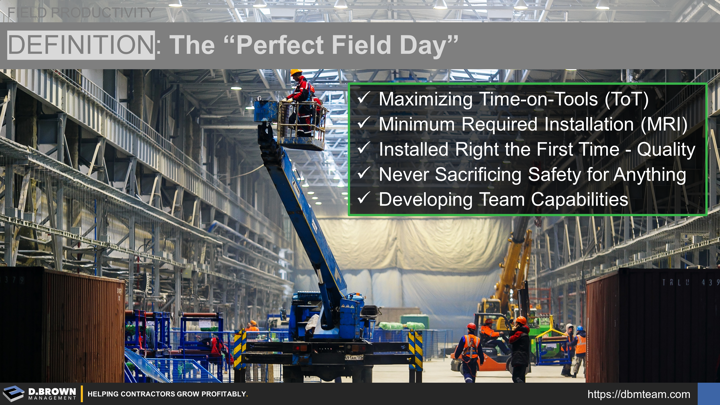The general role of everyone else inside the company and the supply chain is to make sure the crafts people are set up for a “Perfect Day” every day.
This is an aspirational and focusing goal for everyone, with the Foreman being the manager who is directly responsible including feedback and escalations.
The "Perfect Field Day" - Craft Perspective
- They went home the day before knowing exactly what they needed to do the next day including key information and goals so they could be mentally preparing. The subconscious mind is a powerful planning tool and a good night's sleep is one of the best things you can do for health, productivity, and safety.
- They had confidence knowing everything would be ready when they arrived in the morning and also know exactly what to do if they need a "Plan B" or "Plan C."
- They wake up rested in the morning and get ready for work.
- They show up to the job site with their personal tools, PPE, food, and hydration as applicable, reporting to their morning starting point a few minutes before the actual starting time.
- After any morning job site routines including safety and daily huddles, they head directly to their work area which is completely ready for them.
- Within 5 minutes of getting to their work area, they are installing their first unit of work.
- When break and lunch times come around, they are able to take them within a 1-minute walk of their work area, preferably closer with any waiting minimized.
- They don’t have to leave their work areas for information, materials, or tools.
- They are able to work productively, installing materials right up until 5 minutes before quitting time. This may be adjusted for standard daily items like end-of-day huddles to go over the day and the next day. Or the Foreman may have briefed them while they were working.
- They then gather their personal tools, PPE, lunch boxes, etc. and safely leave the jobsite proud of what they have accomplished for the day. They are looking forward both to going home and what is in front of them tomorrow.
At this point they have had about 7 hours of Time-on-Tools as compared to the industry standard, which is closer to 4 or 5 hours per day. This represents a massive improvement to field productivity.
Foreman and Crew Leader Quick Evaluation
- Look at each member of the crew you are responsible for and score their day yesterday on each of these 10 criteria. Pick your own ranking system (0-10, High-Med-Low, etc.). Don't over complicate the format - a notepad works great.
- What is one thing you can do to improve their score today?
- Tomorrow?
Just work to improve a little each day and you will be surprised at how quickly morale and productivity improve. Don't hesitate to talk with the crew members about this. Their feedback and suggestions are invaluable.
The individual crew members own a piece of each of these items. Don't underestimate the cumulative impact of the following.
- Company culture
- Project culture - sometimes those are different as they are influenced by the customer, other trades, and leaders who may not be fully aligned with the company's culture.
- Systems and tools for planning, communication, and training.
- Influence from crew leaders, foremen, general foremen, and/or superintendents on individual crew members.

